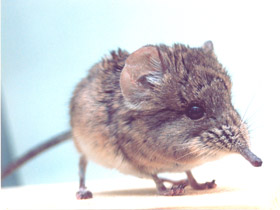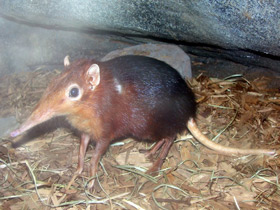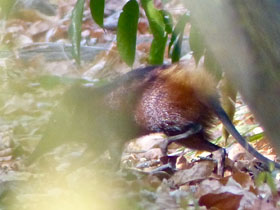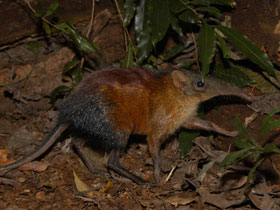Order Elephant-shrews Macroscelidea
In the past, elephant shrews (also called “sengis” which is the Bantu word for elephant shrew) have been classified as part of the order Insectivora, but based on the results of molecular studies, they were placed in their own superorder Afrotheria that includes tenrecs, elephants, sirenians, and hyraxes. This family comprises 17 species of small and medium-sized animals; they vary in size from 10 to 30 cm, and from 50 to 540 g. The traditional common name “elephant-shrew” developed due to the imaginative resemblance between elephant trunks and elongated, sensitive snouts of the elephant-shrews, that they use for finding food. When foraging, these animals poke their noses in leaf litter or soft soil, sniffing for food. Elephant shrews have large ears and eyes (which trait helps distinguish them from insectivores), and long, dense, soft hair. Some of the other remarkable aspects of the elephant-shrew that differ them from representatives of Insectivore order are their more complex brain (which is the reason, among others, for some scientists to suggest that elephant shrews and primates share common ancestors), developed sense organs, and complex behaviour. These funny animals have a thin, hairless, mouse-like tail without a tuft, which comprises 80-120% of the whole body length; both sexes have a special gland under the tail, which produces smelly secretion used for marking. Elephant shrews are exclusively terrestrial animals. Long legs enable a sengi to walk, trot, run, or hop. All elephant shrew species are confined to the African continent, south of the Sahara Desert, including the island of Zanzibar. They are common in the mountains and deserts of southern and eastern regions of the continent.
Elephant-shrews do most of their foraging at night. All elephant-shrews eat mainly insects, spiders, centipedes, millipedes, and earthworms. Small species feed predominantly on ants and termites, while larger elephant shrews consume beetles, spiders, small mammals, bird eggs, and other animal food. Having found its prey, the elephant shrew uses its tongue to flick small food into its mouth, much like an anteater. Some species occasionally eat green parts of plants, seeds, and berries, although elephant shrews rarely drink.
Females give birth to litters of one or two young two to five times a year, after a gestation period varying from 45 to 60 days. The young are born precocial; they have their eyes open and are covered in fur. The newborns are able to run in a few hours after birth but they remain in the nest for several days before coming outside. The young grow fast and are fully weaned already after two weeks. At that time, they begin the migratory phase of their life which lessens the dependency of the young on their mother.



















































